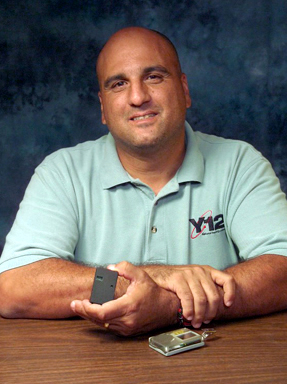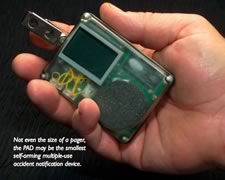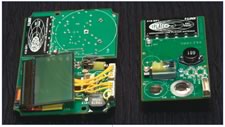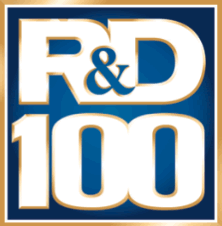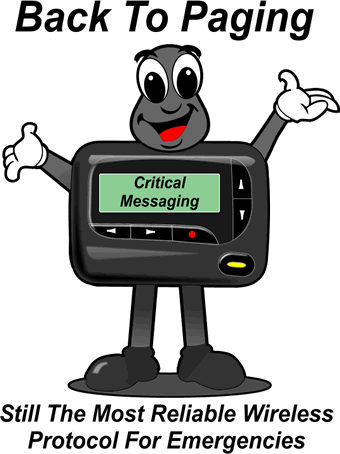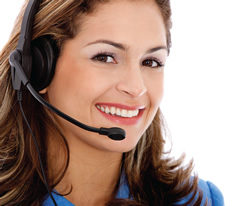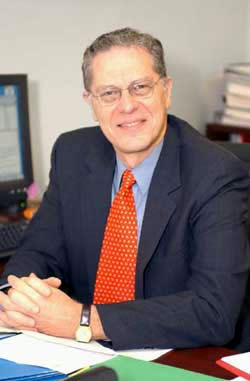BloostonLaw Telecom Update Published by the Law Offices of Blooston, Mordkofsky, Dickens, Duffy & Prendergast, LLP [Portions reproduced here with the firm's permission.] www.bloostonlaw.com |
| Vol. 14, No. 17 | April 27, 2011 |

FCC Sets Tentative Agenda For May 12 Open Meeting The FCC has announced that the following items will be on the tentative agenda for the next open meeting scheduled for Thursday, May 12: - NPRM to Strengthen and Secure America’s Critical Communications Infrastructure: A Notice of Proposed Rulemaking to extend the outage reporting requirements in Part 4 of the rules to interconnected VoIP and broadband service providers to promote the resiliency of America’s 9-1-1 system and the country’s critical communications infrastructure.
- Elimination of the International Settlements Policy NPRM: As part of the Commission's regulatory reform efforts, a Notice of Proposed Rulemaking to remove outdated regulations governing the exchange of telephone traffic between U.S. and foreign carriers that are no longer necessary to protect consumers and competition, while strengthening protections against anticompetitive practices by foreign carriers.
- Streamlining and Modernizing International Data Reporting Requirements First Report and Order and FNPRM: As part of the Commission's Data Innovation Initiative, a First Report and Order and Further Notice of Proposed Rulemaking to eliminate unnecessary reporting requirements regarding international telephone service, while streamlining and modernizing remaining international data reporting to ensure continued relevance in light of changing markets.
BloostonLaw contacts: Hal Mordkofsky, Ben Dickens, Gerry Duffy, and John Prendergast. |

INSIDE THIS ISSUE - BloostonLaw seeks recon of FCC’s draft rules on towers and migratory birds.
- AT&T, Deutsche Telekom file applications for transfer of control of T-Mobile licenses.
- TAC proposes ideas for job creation, tech innovation.
- FCC seeks further comment on 14th video competition report.
|
BloostonLaw Seeks Recon Of FCC’s Draft Rules On Towers and Migratory Birds On behalf of its participating clients, BloostonLaw has filed a Petition for Reconsideration of the FCC’s Public Notice proposing draft rules and interim procedures concerning the environmental effects of proposed communications towers, including their effects on migratory birds (BloostonLaw Telecom Update, March 30 and April 6). The FCC has proposed draft rules and procedures that could significantly affect our clients’ ability to construct an antenna tower in a timely manner. The draft rules and procedures are the result of a decision by the U.S. Court of Appeals for the District of Columbia Circuit in American Bird Conservancy v. FCC that requires the FCC to consider the impact of antenna towers on migratory birds. As part of this process, the FCC has proposed that proponents of antenna structures be required to publish a notice in a local newspaper of general circulation (or otherwise follow applicable local zoning notification processes) regarding the proposed construction or alteration of the antenna structure. Additionally, following the local notice, the proposal would have to be posted on the FCC's website for a period of 30 days in order to allow unknown third parties the opportunity to request that the FCC require the filing of an Environmental Assessment (EA) prior to the submission of an application for Antenna Structure Registration. The potential impact of these rules is significant delay and expense if a request for Environmental Assessment is filed — regardless of how frivolous the request might be. In its petition, BloostonLaw asserts that the position taken by the Commission is erroneous and violates the Administrative Procedure Act (APA) because the draft rules and procedures, when taken in their totality, would give unidentified members of the public new substantive rights which do not exist under current regulations, to the detriment of all applicants proposing the construction of any antenna structure requiring registration with the Commission. Accordingly, the EA Public Notice should be rescinded and an appropriate Notice of Proposed Rulemaking issued. Moreover, the petition continues, the draft rules and procedures are not simply a change in the procedures for filing antenna structure registration (ASR) applications. To the contrary, they provide for newly created substantive rights to unidentified third parties that do not presently exist – namely the right to be notified of and the opportunity to seek environmental review of each and every proposed antenna tower construction and modification requiring FCC registration. Moreover, no standards for seeking review are specified. From all that appears, any member of the public would be able to throw a monkey wrench into the ASR approval process by requesting an EA review, regardless of how baseless the request may be. Even if the request is ultimately denied, the applicant may have suffered substantial injury by being subjected to what could be considerable delay in the approval process – a delay that does not now exist under the present procedure. As a result, proposed rule changes are not merely “procedural”, but instead are substantive in nature and require notice and comment rulemaking. BloostonLaw will also be filing comments in this WT Docket Nos. 08-61 and 03-87 proceeding. The comments are due on Thursday, May 5, 2011. If you wish to participate in these comments, please let us know as soon as possible. BloostonLaw contacts: Hal Mordkofsky and Richard Rubino AT&T, Deutshe Telekom File Applications For FCC Approval of T-Mobile Deal AT&T and Deutsche Telekom have filed applications seeking the FCC’s consent to the transfer of control of the licenses and authorizations held by T-Mobile USA, and its wholly-owned and controlled subsidiaries from Deutsche Telekom to AT&T. The FCC has issued a Public Notice, announcing that the Applications have been filed and that the new WT Docket No. 11-65 proceeding is now governed by permit-but-disclose ex parte procedures that are applicable to non-restricted proceedings under section 1.1206 of the Commission’s rules. The FCC did not establish the pleading cycle for protesting the Applications, but said that a future Public Notice will be issued that will set forth the dates for the filing of pleadings once the applications have been determined to be complete and acceptable for filing. The FCC also noted that, pursuant to section 1.1200(a) of the Commission’s rules, it may adopt modified or more stringent ex parte procedures in particular proceedings if the public interest so requires. BloostonLaw contacts: Hal Mordkofsky, Ben Dickens, Gerry Duffy, and John Prendergast FCC Technical Council Proposes Ideas For Job Creation, Innovation The FCC’s Fifth Technical Advisory Council (TAC) has submitted eight recommendations to identify important areas of innovation and develop informed technology policies supporting U.S. competitiveness and job creation in the global economy. In a letter to FCC Chairman Julius Genachowski, TAC Chairman Tom Wheeler (former CTIA president) explained that the TAC considered not only the potential for economic development and job creation, but also which actions could have the greatest near-term impact on the U.S. economic condition. Wheeler said that each recommendation is an opportunity for the FCC to unleash new private sector innovation and job creation, without working through traditional regulatory processes. By acting on these recommendations, the FCC can promote competition, foster industry best practices, and encourage executive action in order to help innovators, small businesses, and local governments pursue new economic development and job growth. Wheeler said. The recommendations are as follows: 1. Municipal Race-to-the-Top program. The FCC should sponsor a Race-to-the-Top-style awards/recognition program to identify a list of cities with the best practices in terms of broadband infrastructure deployment. The “Broadband City USA” contest could provide top rankings for cities and towns based on being the most broadband-friendly in terms of infrastructure planning, accommodation, and permitting/approvals processes. Cities and towns would have an incentive to compete for this designation, making it a tool to further new investment and economic development. The FCC could also use this program as an opportunity to highlight a host of best identified practices for broadband infrastructure deployment, including model city “rights of way” codes. 2. Broadband Infrastructure Executive Order. The FCC should formally request that the President issue an Executive Order on broadband infrastructure deployment on federal land and in federal buildings. The Executive Order would mandate the following for Federal rights of way and antenna siting approvals: - Single document format for permitting
- Single federal agency to coordinate the permit approval process
- 60-day time frame for approvals
Such an Executive Order would place the Federal government in a position to advance network deployment and resiliency in communities with Federal buildings, especially urban areas where network congestion is most acute. In addition, this Executive Order could advance the development of micro cells, distributed antenna systems (DAS), and other innovative broadband infrastructure, demonstrating a path for growth in this market. 3. Advocacy for Rapid Tower Siting. The FCC should propose that states and municipalities employ a shortened “shot clock” for co-locations on existing structures or permit co-location “by right” — absent special circumstances. The TAC has identified several impediments to tower siting processes which could be overcome through updates to state and local procedures, including: - Inconsistent and non-concurrent time frames for environmental assessments
- Redundant requirements for co-location applications
- Repetitive rejection of incomplete applications without identification of deficiencies.
Expediting the process for tower siting could have an important impact on the development of local broadband access in communities, boosting their marketability to new employers and network access for local entrepreneurs. If states and municipalities do not agree to expedite co-location approvals, the Commission should express its willingness to proceed with a new, shorter “shot clock” rule for co-locations. 4. Best Practices/Technology Outreach to State and Local Governments. The FCC should begin a dialogue with states and municipalities about proven new technologies for efficiently deploying broadband (e.g., micro-trenching, DAS equipment on city light poles, directional boring). The Commission should host a “road show” or series of workshops highlighting best identified practices with new technologies. This road show, in combination with leadership on the federal level through the Executive Order (See recommendation #1), can help accelerate the development of this new market for network infrastructure. 5. Model an Online Deployment Coordination System. The TAC believes that timely access to underground facilities has a direct bearing on infrastructure costs and deployment. The FCC should develop a “white label,” web-based communication tool that can be adopted and labeled as their own by localities to provide advance notification of planned infrastructure projects. Such a web-based capacity would allow all those who must excavate rights-of-way to coordinate openings (i.e., “dig once”) and thus speed deployment and reduce costs and civic disruption. Any state or municipality could voluntarily use the FCC model to implement its own “reverse one-call” system to provide notification of new infrastructure projects. 6. New Metrics to Measure Broadband Network Quality. The TAC believes that, for some usage models, developing metrics beyond throughput speed to measure the quality of Internet Protocol (IP) broadband networks is important for helping the IP ecosystem flourish by enabling "extended" quality standards that can support the subset of applications that require not only fast, but precise, timely and reliable broadband networks. Simply measuring broadband networks by throughput speed does not provide a full picture nor set sufficient performance parameters to support uses with "extended" quality requirements such as healthcare monitoring, emergency services, alarms, etc. Although network services that meet such extended criteria may not be offered by all service providers, or included in all service plans, it would be beneficial to have common metrics for them. Additionally, in transitioning to IP based networks the TAC will be identifying how reliability can be characterized in a multi-modal environment — where reliability is provided by having many alternate paths, means and/or modes of communications. The FCC should initiate the steps necessary for determining how this aspect of the transition will impact the basic architecture of emergency services. 7. Highlight Stranded PSTN Investments. Network providers have huge investments in existing public switched telephone network (PSTN) infrastructure including copper wire, switches, pole space, and software. Although new information services are designed for IP networks, many homes and businesses still use devices that depend on specific characteristics of the PSTN (e.g., auto-dialers, alarm systems, ATMs, PoS terminals). These services and devices will have to be replaced and the accompanying construction and inspection "codes" revised. The TAC will be creating an inventory of such services. The TAC recommends that the FCC should highlight this concern and initiate a public dialogue so that the technology and know-how for replacing such services is widely disseminated. The TAC in the coming months will conduct a further technical analysis of the potential short term, and low cost transitions of this legacy infrastructure, including new, IP-enabled devices and the use of traditional copper lines for high speed, high quality broadband. 8. Promote Small Cell Deployment. Small cell deployments have the ability to greatly increase spectral efficiency to meet demands of increasing teledensity. The FCC, with the participation of other relevant agencies (e.g., General Services Administration) should convene an industry-led group (e.g., providers, vendors, standards groups, and building owners) to discuss ways to accelerate the deployment of small cell wireless devices (i.e., femtocells, DAS, Wi-Fi) in commercial and government buildings and other high teledensity venues. Accelerating this deployment would meet growing market demand for mobile broadband in dense, urban areas and potentially create new employment for design, installation, and operation of wireless systems. The TAC said that two ideas in particular that should be explored: (1) development of “universal architectures” for picocells, femtocells, etc., perhaps leveraging convergence around LTE, so that multiple providers using multiple spectrum bands could be served from a single device; and (2) creation of a new “small cell band” spectrum allocation, conceptually a hybrid between licensed and unlicensed spectrum, in which property owners and/or mobile broadband providers would have the ability to freely deploy networks to offload broadband services from other networks with assurances of interference protection from neighboring users. BloostonLaw contacts: Hal Mordkofsky, Ben Dickens, Gerry Duffy, and John Prendergast. FCC SEEKS FURTHER COMMENT ON 14th VIDEO COMPETITION REPORT: The FCC has issued a Further Notice of Inquiry (NOI) soliciting data, information, and comment on the state of competition in the delivery of video programming for its 14th Video Competition Report. Comments in this MB Docket No. 07-269 proceeding are due June 8, and replies are due July 8. The Commission noted it has initiated a comprehensive review of the way in which it uses data, including data used for its statutory competition reports. In the course of that review, the FCC determined that the data submitted in response to the notices of inquiry for the 14th Report are insufficient to produce an adequate report. The FCC is therefore requesting additional data for 2009 and for the first time asking for data for 2010. In submitting additional data for 2009 and new data for 2010, to the extent that it is not unduly burdensome, the FCC encourages commenters to also submit comparable historical data for 2007 and 2008, which will facilitate the Commission’s analysis of trends. The FCC said it intends to adopt a number of changes to our analytic framework to ensure that we are collecting and presenting the most useful information concerning competition in the video programming market. Importantly, this new framework will also allow the Commission to present competitive data in a uniform manner that is consistent in format with the recently revised Mobile Wireless Competition Report. Of particular note, in the 14th Report, the FCC plans to include Online Video Distributors (OVDs) for the first time, in light of the growing importance of online video distribution to consumers. BloostonLaw contact: Gerry Duffy. REP. STEARNS INTRODUCES “CONSUMER PRIVACY PROTECTION ACT”: U.S. Rep. Cliff Stearns (R-Fla.) recently introduced the Consumer Privacy Protection Act, which is designed to offer consumers online privacy protection. Stearns said his bill “requires covered entities to provide consumers in clear and easy to understand language what information is being collected and how the information is being used. It also provides incentives for covered entities to enter into strong self-regulatory standards.” The legislation would: - Require covered entities to notify consumers that their personally identifiable information as defined in the bill may be used for a purpose unrelated to the transaction.
- Require entities to notify consumers of any material change in their privacy policy.
- Require covered entities to establish a privacy policy with respect to the collection, sale, disclosure for consideration, or use of the consumer's information and such policy be made easily available for consumers.
- Require an entity to provide consumers the opportunity to preclude the sale or disclosure of their information to any organization that is not an information-sharing partner.
- Provide for a Federal Trade Commission (FTC) approved five-year self-regulatory program and prescribes requirements for a self-regulatory consumer dispute resolution process.
- Require the FTC to presume that an entity is in compliance with this Act if it participates in an approved self-regulatory program.
BloostonLaw contacts: Hal Mordkofsky, Ben Dickens, Gerry Duffy, and John Prendergast. REP. LATTA INTRODUCES “SPECTRUM INNOVATION ACT,” CALLING FOR INCENTIVE AUCTIONS: U.S. Rep. Robert E. Latta (R–Ohio) has introduced the Spectrum Innovation Act, which would authorize the FCC to hold incentive auctions. The legislation would give the Commission one year to establish rules for incentive auction revenue sharing. A bill (S. 28) is pending in the Senate that would also authorize incentive auctions. Latta said his bill would “incentivize existing spectrum licensees to voluntarily relinquish a part or all of their spectrum in exchange for a portion of the proceeds generated by the auction.” Allowing the FCC to conduct incentive auctions of spectrum could generate billions of dollars in revenues; the auction revenue would help pay down the United States $14.2 trillion debt, Latta said. BloostonLaw contacts: Hal Mordkofsky, John Prendergast, and Cary Mitchell. NCTA-BACKED STUDY SAYS RUS USED STIMULUS MONEY TO DUPLICATE SERVICE IN CERTAIN AREAS: The National Cable and Telecommunications Association (NCTA) has released a study illustrating that three large broadband projects funded by stimulus money from the Rural Utilities Service (RUS) cover markets already served by broadband service providers, reports FierceWirelessBroadband and PC World. According to the study, more than 85 percent of the households covered by the three broadband stimulus projects either have wired or fixed wireless broadband service available to them, not including 3G services. When 3G services are accounted for, nearly 99 percent of the households are covered by the three projects, which are located in northeastern Minnesota, southwestern Montana and northwestern Kansas. The three projects will provide fiber services to the home, which offers tens of megabits of speed over digital subscriber line (DSL) and third generation (3G) wireless services available in these areas. "While it may be too early for a comprehensive assessment of the ARRA's [Recovery Act’s] broadband programs, it is not too early to conclude that, at least in some cases, millions of dollars in grants and loans have been made in areas where a significant majority of households already have broadband coverage," wrote study authors Jeffrey Eisenach and Kevin Caves of Navigant Economics, an analysis firm based in Chicago. "In addition, the [RUS] program creates strong disincentives to private broadband investment in the long run, as potential future investors will discount expected returns for the possibility that the government may step in, ex post, to subsidize a competitor." According to PC World, the authors of this study said the cost of delivering broadband to each unserved home in the three projects is $30,104, if 3G isn't part of the broadband equation. With 3G added, the cost increases to $349,234 per unserved home. Further, PC World notes that RUS gave the Kansas project $101.2 million in grants and loans to cover 4,247 square miles with fiber- or Wi-Max-based broadband, while the Montana project received $64.1 million in grants and loans to cover 154 square miles in Gallatin County with a fiber network. The Lake County Fiber Network project in Minnesota received $66.4 million to build a fiber network in Lake County and parts of St. Louis County, PC World said. It added that the study reports that within the service area of the fiber project in Kansas, five companies offer seven broadband services, including 3G services, the study indicated. Seven providers offer service in Montana, while eight providers sell service, including 3G, in Minnesota. In some instances, these providers offer service to a small percentage of residents within the project areas, PC World said. RUS challenged the study, stating that the awards process was “fair and open,” and that all applicants were “carefully vetted.” BloostonLaw contacts: Ben Dickens, Gerry Duffy, and Mary Sisak. 
BloostonLaw Telecom Update Published by the Law Offices of Blooston, Mordkofsky, Dickens, Duffy & Prendergast, LLP [Portions reproduced here with the firm's permission.] www.bloostonlaw.com |
| Vol. 14, No. 18 | May 4, 2011 |

FCC Sets Comment Cycle For AT&T, DT Apps On T-Mobile Deal The FCC has established a pleading cycle regarding AT&T and Deutsche Telekom’s (DT’s) applications to transfer control of T-Mobile USA licenses to AT&T. As reported previously, AT&T has agreed to acquire from Deutsche Telekom all of the stock of T-Mobile, subject to obtaining all necessary regulatory approvals. Any clients that believe that they will be harmed by the proposed merger, due to, e.g., loss of a roaming relationship or undue concentration of spectrum in their market should contact us ASAP. Interested parties must file petitions to deny no later than May 31, 2011. Persons and entities that file petitions to deny become parties to the proceeding. They may participate fully in the proceeding, including seeking reconsideration of decisions, and filing appeals of a final decision to the courts. Oppositions to such pleadings must be filed no later than June 10, 2011. Replies to such pleadings must be filed no later than June 20, 2011. All filings concerning matters referenced in this Public Notice should refer to DA 11-799 and WT Docket No. 11-65, as well as the specific file numbers of the individual applications or other matters to which the filings pertain. BloostonLaw contacts: Hal Mordkofsky, Ben Dickens, Gerry Duffy, and John Prendergast. |

INSIDE THIS ISSUE - Tier 1 wireless carriers respond to Congress on privacy protection.
- FCC proposes to collect $335.8 million in regulatory fees.
- BloostonLaw proposes “safe harbors” for certain qualified towers.
- Millennium 2000 seeks forbearance from requirement that ETCs provide service over their own facilities.
|
Tier 1 Wireless Carriers Respond To Congress On Privacy Protection Responding to a request from the Congressional Bipartisan Privacy Caucus, the nation's Tier 1 wireless carriers (AT&T, Sprint, Verizon, and T-Mobile) defended the way they collect and store subscribers' location data. In letters to Reps. Ed Markey (D-Mass.) and Joe Barton (R-Texas), co-chairmen of the Privacy Caucus, the carriers argued that although they collect location data information for network maintenance, they do not rent or sell any of that information. The Privacy Caucus had asked the carriers to explain what personal information they collect, how they use it, and whether it is used for marketing purposes. In their responses, the carriers said that they ask for subscribers' consent before tracking their location, but they acknowledged that they cannot control how third-party applications that subscribers download will use their location information. Specifically, AT&T affirmed that it does not use such data regarding “telecommunications services.” Regarding data services, the company said it asks customers for prior consent to use the information for commercial purposes. Sprint said it uses such data to provide products and services to its customers; “customize or personalize customers’ experiences with Sprint services; protect Sprint’s and customers’ rights and property; provide personalized advertising and communications to customers; monitor services and the network; and respond to the ‘legal process’ and emergencies.” T-Mobile said it collects personal information when customers sign up for service. This includes personal contact, billing, and credit information. The company insists, however, that it does not sell or market this data, and that it complies with the FCC’s customer proprietary network information (CPNI) rules. While affirming that it complies with FCC privacy rules, Verizon Wireless was the only Tier 1 carrier to note that it would be implementing a “warning label” on its products. According to the carrier, the label will state: “This device is capable of determining its (and your) physical, geographical location and can associate this location data with other customer information.” The label then refers the customer to the Verizon “User’s Guide” to restrict access to personal data. In a statement, Rep. Markey said: "The responses of the wireless carriers provide important insights into how each company collects, uses and stores personal location data, including examples of how consumers can grant or withhold consent when location-based services are utilized." Markey also said that encryption and related security technologies were utilized to varying degrees across the four wireless carriers, and sensitive data was retained for differing periods of time. Still, he was uneasy about the role of third parties’ access to personal data. Further, he said that: "Personal data should be made unreadable to those without a legitimate need to access it to the greatest extent possible, and the data should not be retained longer than absolutely necessary. Otherwise, there is a heightened risk of security breaches that expose consumers to identity theft and other crimes.” Rep. Barton said he was “left with a feeling of uneasiness and uncertainty." He said that “the companies informed us that customer consent before access of location data is a common practice, but the disconnect is when third-party applications come in to play. While I am happy to hear that carriers inform their customers of the risks of using independent third-party applications, third-party developers can access the location of customers anytime they want. This is a huge problem. They shouldn't have free reign over your location data and personally identifiable information. I believe it is time we hold third-party developers accountable….” BloostonLaw contacts: Hal Mordkofsky, John Prendergast, and Cary Mitchell. FCC Proposes To Collect $335.8 Million in Reg Fees The FCC has adopted a Notice of Proposed Rulemaking (NPRM), proposing to collect $335,794,000 in regulatory fees for Fiscal Year (FY) 2011. The annual regulatory fee amount to be collected is established each year in the Commission’s Annual Appropriations Act which is adopted by Congress and signed by the President and which funds the Commission. In this annual regulatory fee proceeding, the FCC said it will retain many of the established methods, policies, and procedures for collecting regulatory fees adopted by the Commission in prior years. The FCC intends to collect these regulatory fees during a September 2011 filing window in order to collect the required amount by the end of our fiscal year. The FCC said it will use the same regulatory fee assessment methodology adopted in FY 2010 and in prior years. In the NPRM, the FCC said that during this transition to digital TV, licensees of Low Power, Class A, and TV Translator/Booster facilities may be operating in analog mode, in digital mode, or in an analog and digital simulcast mode. For regulatory fee purposes, a fee will be assessed for each facility operating either in an analog or digital mode. In instances in which a licensee is operating in both an analog and digital mode as a simulcast, a single regulatory fee will be assessed for this analog facility that has a digital companion channel. As greater numbers of facilities convert to digital mode, the Commission will provide revised instructions on how regulatory fees will be assessed. In many categories, the fees are going up. However, for commercial mobile radio service (CMRS), the FCC proposes in FY 2011 to maintain the regulatory fee rate at $0.08 per subscriber due to the declining subscriber base in this industry. As it did in FY 2010, the FCC proposes to limit the increase of the FY 2011 interstate telecommunications service provider (ITSP) fee rate to $.00361 per revenue dollar, and assess a slightly higher fee across all other regulatory fee categories. The Commission also noted that a regulatee’s mere allegation of financial hardship does not automatically entitle it to a deferral of its obligation to pay regulatory fees; only a properly supported claim of financial hardship will entitle the regulatee to a deferral. Accordingly, the FCC indicates that if a request for deferral is not supported by documentation of financial hardship, it will be denied, and an associated petition for waiver or reduction will be dismissed. A regulatee cannot delay payment on the theory that its deferral request triggered an automatic six-month extension of its obligation to pay. The FCC thus proposes to amend section 1.1166 (b) of its Rules to read, “Deferrals of fees, if granted, will be for a designated period of time not to exceed six months.” In FY 2011, the Commission said it will promote greater use of technology (and less use of paper) to improve the regulatory fee notification and collection process. In addition to seeking comment on the specific initiatives discussed in the paragraphs below, we ask whether there are other steps we could take to promote greater use of technology in collecting regulatory fees. Comments in this MD Docket No. 11-76 proceeding are due May 24, and replies are due June 1. BloostonLaw contacts: Hal Mordkofsky, John Prendergast, Gerry Duffy, and Richard Rubino. BloostonLaw Proposes “Safe Harbors” For Certain Qualified Towers On behalf of its participating clients, BloostonLaw has filed comments in response to the FCC’s public notice proposing interim rules for the processing of applications for Antenna Structure Registration (ASR). As noted in BloostonLaw’s recent petition for reconsideration (BloostonLaw Telecom Update, April 27), the FCC has proposed draft rules and procedures that could significantly affect a client’s ability to construct an antenna tower in a timely manner. The draft rules and procedures are the result of a decision by the U.S. Court of Appeals for the District of Columbia Circuit in American Bird Conservancy v. FCC that requires the FCC to consider the impact of antenna towers on migratory birds. As part of this process, the FCC has proposed that the proponent of any antenna structure requiring antenna structure registration (ASR) be required to publish a notice in a local newspaper of general circulation (or otherwise follow your local zoning notification processes) regarding the proposed construction or alteration of the antenna structure. Additionally, following the local notice, the proposal would have to be posted on the FCC's website for a period of 30 days in order to allow unknown third parties the opportunity to request that the FCC require you to file an Environmental Assessment prior to the submission of an ASR application. The potential impact of these rules is significant delay and expense if a request for Environmental Assessment is filed— regardless of how frivolous the request might be. In its comments, BloostonLaw urged the Commission to narrow the scope of antenna structures that would be subject to environmental review, by advocating safe harbors for antenna structures meeting certain height requirements and utilizing high intensity and/or medium intensity white obstruction lighting (since it is red tower lights that have been identified as the main tower-related issue for migratory birds). This would clear the vast majority of applications for ASRs from being subject to environmental processing due to avian mortality concerns. Additionally, for those proposals that would be subject to environmental review, BloostonLaw has proposed a “shot-clock” mechanism that would deem the issuance of a Finding of No Significant Impact (FONSI) if the FCC did not act within a defined period of time. BloostonLaw contacts: Hal Mordkofsky and Richard Rubino. MILLENNIUM 2000 SEEKS FORBEARANCE FROM REQUIREMENT THAT ETCs PROVIDE SERVICE OVER THEIR OWN FACILITIES: The FCC’s Wireline Competition Bureau (WCB) seeks comment on a petition filed by Millennium 2000, Inc., a mobile virtual network operator, for forbearance from the requirement in section 214(e)(1)(A) of the Communications Act, that eligible telecommunications carriers (ETCs) provide service, at least in part, over their own facilities. Millennium 2000 seeks forbearance to enable it to be designated an ETC for the limited purposes of receiving universal service Lifeline support. Comments in this CC Docket No. 96-45 and WC Docket No. 09-197 proceeding are due May 27, and replies are due June 13. BloostonLaw contacts: Ben Dickens, Gerry Duffy, and Mary Sisak. COMMENT SOUGHT ON ADDITION TO FCC’s LEGISLATIVE MANAGEMENT TRACKING SYSTEM: Pursuant to the Privacy Act of 1974, the FCC proposes to add a new system of records, FCC/OLA-1, “Legislative Management Tracking System (LMTS).'' The FCC said its Office of Legislative Affairs (OLA) will use the information contained in FCC/OLA-1 to cover the personally identifiable information (PII) in the Commission's Legislative Management Tracking System (LMTS). OLA uses LMTS to store, track, and manage correspondence from the members of the U.S. House of Representatives and the U.S. Senate and the President of the United States and the Vice President of the United States. This correspondence may include attachments that could contain PII from individuals who contacted their Congressional Representative(s) and/or Senator(s) and/or the President and/or the Vice President concerning various telecommunications issues affecting them, e.g., telephone and cable bills, etc. In addition, FCC employees may be seeking Congressional assistance with their personal employment issues at the Commission, e.g., hiring and promotion matters, etc. Comments in this FR Doc No: 2011-10202 proceeding are due May 31 to Leslie F. Smith, Privacy Analyst, Performance Evaluation and Records Management (PERM), Room 1-C216, Federal Communications Commission (FCC), 445 12th Street, SW., Washington, DC 20554, or via the Internet at Leslie.Smith@fcc.gov. Congress may submit comments on or before June 7. The proposed new system of records will become effective on June 7, unless the FCC receives comments that require a contrary determination. The Commission said it will publish a document in the Federal Register notifying the public if any changes are necessary. BloostonLaw contacts: Hal Mordkofsky, Ben Dickens, Gerry Duffy, and John Prendergast. COMMENT CYCLE SET FOR NOI ON NETWORK RELIABILITY & CONTINUITY: The FCC has established a comment cycle for its Notice of Inquiry (NOI) into a broad range of issues regarding the reliability and resiliency of U.S. communications networks. The FCC said its goal is to establish a vigorous dialog with all interested stake-holders, particularly with respect to what action, if any, should be taken by the Commission to address these matters. In addition, the Commission seeks comment on whether it should terminate the following proceedings: Effects on Broadband Communications Networks of Damage or Failure of Network Equipment or Severe Overload, and Independent Panel Reviewing the Impact of Hurricane Katrina on Communications Networks. If these two earlier proceedings were to be terminated, the FCC said, the record developed therein would be consolidated into this single new proceeding, which will enable the Commission to consider all relevant matters in a more comprehensive fashion. Comments with respect to the proposed termination of PS Docket 10-92 and EB Docket 06-119 are due on or before May 31. Comments with respect to all other matters raised in this document are due July 7, and reply comments are due September 1. BloostonLaw contacts: Ben Dickens, Gerry Duffy, and Mary Sisak. ETC ANNUAL LIFELINE CERTIFICATION DUE AUGUST 31: The FCC has issued a reminder that each year, eligible telecommunications carriers (ETCs) are required to verify the continued eligibility of a statistically valid sample of their Lifeline subscribers. Currently, states that have their own state-based low-income programs are required to establish state-specific verification procedures. These state procedures should include methods that ETCs should use to verify continued eligibility and should specify to whom the results should be submitted. States that do not have state-based low-income programs are designated “federal default states.” ETCs in federal default states must verify annually the continued eligibility of a statistically valid sample of their Lifeline subscribers. The FCC’s reminder states that an ETC in a state with its own state-based low-income program must submit a certification, signed by an officer of the company, to the Universal Service Administrative Company (USAC) by August 31, 2011, attesting that the ETC has complied with the state verification procedures. In addition, all ETCs in federal default states must submit their annual Lifeline verification survey results to USAC by August 31, 2011. ETCs choosing to submit their certifications by mail should ensure that USAC receives the certifications by the August 31 date. BloostonLaw contacts: Ben Dickens, Gerry Duffy, and Mary Sisak. COMMENT DATES SET FOR FNPRM ON DISCLOSURES REGARDING EX PARTE DISCUSSIONS: The FCC has set comment dates for its Further Notice of Proposed Rulemaking (FNPRM) on amending its rules to require that notices of ex parte discussions disclose real parties-in-interest. The change was proposed because the existing rules do not enable interested parties to know whose interests are being represented when a contact is made. By requiring the disclosure of this information the proposed amendment would increase transparency and openness in Commission proceedings, the FCC said. The FNPRM was adopted in conjunction with a Report and Order amending the ex parte rules. Comments in this CG Docket No. 10-43 proceeding are due June 16, and replies are due July 18. Comment is sought on the suitability of using existing judicial disclosure rules, such as Supreme Court Rules 29.6 and 37.6, or Rule 26.1 of the Rules for the U.S. Court of Appeals for the District of Columbia Circuit. Comment is also sought on the possible use of the Lobbying Disclosure Act as a model. Hal Mordkofsky, Ben Dickens, Gerry Duffy, and John Prendergast. COMMENT CYCLE SET FOR FNPRM REGARDING VRS CERTIFICATION: The FCC has set a comment cycle for its Further Notice of Proposed Rulemaking (FNPRM) regarding proposed modifications to its certification process for Internet-based relay providers to ensure that all entities seeking certification to provide Internet-based telecommunications relay services (TRS) in the future—or currently certified entities seeking re-certification—are fully qualified to provide Internet-based relay service in compliance with the Commission's rules and requirements, and to improve the Commission's oversight of these providers, once they have been certified (Blooston Telecom Update, April 13). The FNPRM specifically addresses video relay service (VRS). Comments in this CG Docket No. 10-51 proceeding are due June 1, and replies are due June 16. Simultaneously with the VRS FNPRM, the Commission issued a Report and Order adopting rules to detect and prevent fraud and abuse in the provision of video relay service. BloostonLaw contact: Gerry Duffy. FCC SETS COMMENT DATES FOR NPRM REGARDING EXTENDING VRS RATES: The FCC has set a comment cycle for its Notice of Proposed Rulemaking (NPRM) tentatively concluding that it will extend the current video relay service (VRS) rates for the upcoming fund year. The Commission is considering various options for reforming the VRS industry (see story above), and therefore proposes to maintain the current rates until new VRS rules are adopted. The intended effect of this action is to ensure stability and certainty for VRS while the Commission continues to evaluate the issues and the substantial record developed in response to the reform proceeding. Comments in this CG Docket Nos. 10-51 and 03-123 proceeding are due May 16, and replies are due May 23. BloostonLaw contact: Gerry Duffy. CTI ANNOUNCES RURAL LTE AGREEMENT WITH VERIZON WIRELESS; Convergence Technologies Inc (CTI) has announced that it has entered into an agreement with Verizon Wireless to participate in the company’s [Long Term Evolution] LTE in Rural America program. CTI provides service in Illinois and Indiana. Under the program, CTI will work with Verizon Wireless to deliver 4G LTE services to rural Indiana communities within the IN-5 Cellular Market Area. Under the agreement, Verizon Wireless will lease to CTI its 700 MHz upper C block wireless spectrum in the CTI service area where Verizon Wireless has not already constructed a network.. This project will leverage portions of CTI’s recent $18 million Broadband Stimulus Project to bring advanced 4G wireless services to underserved rural communities throughout Illinois and Indiana. CTI expects 4G LTE speeds of up to 12 Mbps for downloads and up to 5 Mbps for uploads. Charles Wu, Convergence Technologies CEO stated “This partnership with Verizon Wireless creates a regional powerhouse that combines CTI’s existing network and spectrum assets with a data-roaming agreement from the leading wireless network company. CTI 4G LTE customers will be able to roam on the Verizon Wireless 4G LTE network throughout the country and Verizon Wireless customers will be able to roam on the CTI 4G LTE network. These added LTE lease areas will increase CTI’s 4G mobile wireless coverage to over 750,000 POPs across Illinois and Indiana.” Wu added “In addition to offering voice and high-speed broadband services, 4G LTE technology will enable a variety of innovative value-added services within the mobile ecosystem. CTI plans to capitalizing on this by combining its 4G mobile carrier assets with its IP Pay payments platform, currently processing over $500 million in annual volume, to develop a mobile payments solution to address a market projected to exceed $280 billion in North America by 2014.” This newsletter is not intended to provide legal advice. Those interested in more information should contact the firm. |



